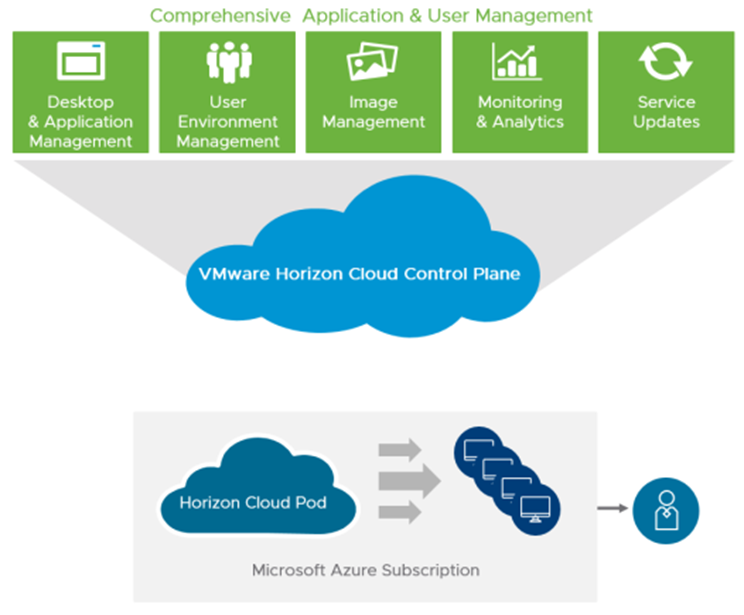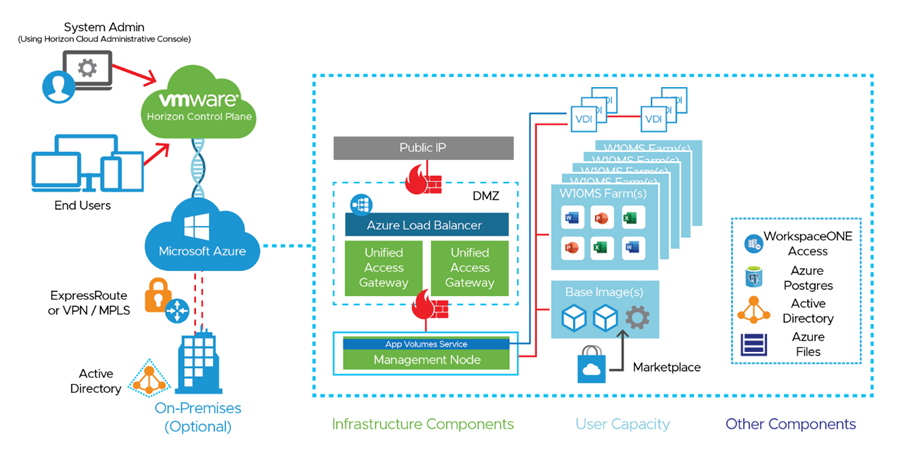In today’s fast-paced and digitally-driven world, organizations are increasingly seeking innovative solutions to enable flexible and secure access to desktops and applications. VMware Horizon, coupled with the power of Microsoft Azure, offers a powerful combination that revolutionizes how businesses approach virtual desktop infrastructure (VDI) and Desktop as a Service (DaaS).
This dynamic duo provides a scalable, secure, and streamlined desktop virtualization experience that empowers organizations to embrace the future of work. In this blog, we will explore the benefits and capabilities of VMware Horizon on Microsoft Azure and how it enables organizations to optimize their desktop virtualization strategy.
This article explains DaaS and, more importantly, how you can leverage the potential of Azure cloud infrastructure by integrating VMware Horizon with it.
What is DaaS?
Desktop-as-a-Service (DaaS) is a cloud service wherein a third-party cloud service provider delivers virtual desktops to users’ devices using the internet. DaaS helps remove another layer of management from IT as most of the environment is managed by the vendor (see image below for more context). It moves the expense model from CapEx to OpEx because the organization does not have to invest in hardware and software capacity beforehand.

Why Integrate VMware Horizon with Microsoft Azure?
VMware Horizon is a feature-rich VDI platform that enables organizations to deliver virtual desktops and applications to end-users, regardless of their location or device. It provides a seamless and consistent user experience, enhanced security, and simplified management.
It has some really cool features which make it popular. These include instant provisioning, dynamic session management, and advanced monitoring. VMware Horizon empowers IT teams to efficiently deploy and manage virtual desktop environments.
You can leverage the power and scalability of Azure’s cloud infrastructure by integrating VMware Horizon with it. Cloud services provide a secure and reliable foundation for hosting virtual desktops, enabling businesses to scale their deployments as per their needs. You can ensure low-latency access to virtual desktops for users across different geographical locations using Azure’s global data centers.
Horizon Cloud on Microsoft Azure uses a software-as-a-service (SaaS) model. This service comprises multiple software components.

Horizon Cloud Service
The Horizon Cloud Service offers a unified cloud control plane, managed by VMware, that simplifies the orchestration and administration of remote desktops and applications within your Microsoft Azure environment. It allows you to leverage one or multiple subscriptions in Azure Cloud Platform for your virtual desktop infrastructure.
The great thing about VMware hosting the Horizon Cloud Service control plane is that you can benefit from seamless SaaS updates and enhancements. This service operates across various Microsoft Azure regions, ensuring widespread availability and scalability.
Horizon Cloud Administration Console
The Horizon Cloud Administration Console, a user-friendly management interface, is hosted within the cloud control plane. You can access it through standard web browsers, and it serves as a central hub for managing user assignments, virtual desktops, RDSH-published desktop sessions, and applications.
The Administration Console allows you to perform these management tasks efficiently and effectively. This service is currently deployed across multiple Azure regions, providing maximum accessibility and flexibility regardless of your location or time zone.
Deployment Model
Achieving a smooth and effective implementation of VMware Horizon Cloud Service on Microsoft Azure requires careful planning and a comprehensive grasp of the platform. Let’s delve into the available design options and highlight the specific design decisions made to meet the design requirements outlined in this reference architecture.
The fundamental components of the Horizon Cloud Service encompass the following:
- Horizon Cloud Control Plane
- Horizon Cloud Manager virtual machine, responsible for hosting the user-friendly Administration Console UI
- VMware Unified Access Gateway
- Horizon Agent
- VMware Horizon Client
- VMware App Volumes
The diagram below presents a high-level logical AWS architecture depicting these core elements. Other components are included for illustrative purposes, aiding in visualizing the overall system structure.

The diagram is the foundational logical architecture of a Horizon Cloud Service pod deployed on your Microsoft Azure infrastructure.
- Your Microsoft Azure infrastructure serves as the underlying capacity, providing the necessary resources for the deployment.
- By utilizing a service principal in Microsoft Azure, your Horizon Cloud Service control plane is granted the authorization to create and manage resources.
- You have the flexibility to incorporate additional components, such as Active Directory, as well as optional components like a VMware Workspace ONE Access Connector or RDS license servers.
Horizon Cloud Manager VM
The Horizon Cloud Service control plane takes charge of deploying essential infrastructure components, including the Horizon Cloud Manager VM, Unified Access Gateway appliances for secure remote access, and other components that facilitate the configuration and management of the Horizon Cloud Service infrastructure.
Once you have successfully deployed the Horizon Cloud Service pod, you have the option to connect it to your existing corporate Azure AD infrastructure or create a new AD configuration within your Microsoft Azure subscription. Moreover, you can deploy VMs from the Microsoft Azure marketplace, which can be sealed into images and used in RDSH server farms.
Through the VDI functionality, you gain the ability to create both dedicated and floating desktop assignments with Windows 10.
You can leverage RDSH Farms to deliver session-based desktops and applications to end-users.
Farms provides the means to deliver session-based desktops based on Windows 10 Multi-Session VMs, extending flexibility and efficiency to your virtual desktop environment.
Key Benefits of Integrating VMware Horizon with Azure
Flexible Deployment Models
VMware Horizon on Microsoft Azure offers flexible deployment models to suit the unique requirements of businesses. You can choose between a cloud-hosted deployment, where the Horizon infrastructure runs entirely on Azure, or a hybrid deployment, where a portion of the infrastructure resides on-premises and the rest on Azure.
This flexibility lets you tailor your VDI environment to your specific needs, whether you require full cloud adoption or prefer a hybrid approach for data control and compliance.
Scalability and Cost Efficiency
Microsoft Azure’s scalability and consumption-based pricing model align perfectly with the dynamic nature of VDI workloads. With VMware Horizon on Azure, you can scale your virtual desktop infrastructure up or down based on demand, thus ensuring optimal performance and cost efficiency.
Azure offers a pay-as-you-go model, thus eliminating the need for you to make upfront infrastructure investments, allowing you to pay only for the resources you consume.
Enhanced Security and Compliance
Security is a top priority in the virtual desktop environment. VMware Horizon integrates with Azure Active Directory (Azure AD) for identity and access management, providing enhanced security features such as multi-factor authentication and conditional access policies.
Azure’s built-in security controls, including Azure Security Center and Azure Sentinel, further bolster the security posture of the virtual desktop infrastructure. Additionally, VMware Horizon enables you to enforce granular access controls, data encryption, and desktop-level policies, ensuring compliance with industry and regulatory standards.
Streamlined Management and Monitoring
The combination of VMware Horizon and Microsoft Azure simplifies managing and monitoring virtual desktop environments. Administrators can leverage Azure’s management tools, such as Azure Monitor and Azure Automation, to gain insights into the performance, health, and usage of virtual desktops.
VMware Horizon provides a centralized management console that allows administrators to efficiently provision, monitor, and troubleshoot virtual desktops and applications, reducing the administrative burden and ensuring a smooth end-user experience.
Conclusion
Integrating VMware Horizon with Microsoft Azure enables organizations to unlock the full potential of the virtual desktop infrastructure. It is a powerful combination that offers a flexible and reliable solution for delivering virtual desktops and applications to users across the globe. By embracing VMware Horizon on Microsoft Azure, you can optimize your desktop virtualization strategy, drive productivity, and provide a superior end-user experience in the evolving digital workplace.
If you need any assistance in integrating VMware Horizon with Microsoft Azure, contact us at [email protected]. Our team will book you a free consultation session.

